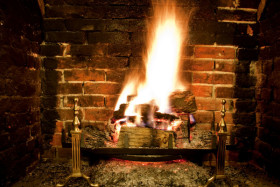Chimney health hazards you should know about
It’s no secret that chimneys are dirty places. What might not be so obvious is that the substances that collect within your chimney can pose some serious health hazards. It’s important to know what chimney health hazards might affect your home and family and how to avoid those hazards.
Some chimney health hazards include:
- Creosote exposure. Creosote forms within your chimney every time you burn wood. The dark, tar-like substance can cause serious health problems if you come into contact with it. Creosote can cause skin and eye irritation. If ingested, it can damage and irritate your kidneys, lungs and liver. Long-term exposure to creosote has been linked to mental problems and cancer.
- Smoke and soot inhalation. Smoke and soot travel up your chimney each time you light a fire. However, some of that smoke might be making its way back into your home and into the air you breathe. Smoke and soot inhalation can cause breathing problems, aggravate asthma and cause bronchitis. Long-term wood smoke and soot inhalation also can lead to lung cancer.
- Carbon monoxide poisoning. All combustion creates carbon monoxide. Like smoke, carbon monoxide should be traveling up your chimney and safely out of your home. If your chimney is blocked or not functioning properly, however, that carbon monoxide can build up within your home and sicken you and your family. Carbon monoxide poisoning causes headaches, nausea, dizziness, fatigue, loss of consciousness, organ damage and even death.
Before you swear off using your fireplace, know that there are ways that you can safely burn a fire within your home, without compromising your health or the health of your family. To protect your family from chimney hazards:
- Have your chimney swept and inspected by a certified chimney sweep at least once per year. Your annual chimney sweep will remove hazardous creosote and soot from your chimney, reducing the chances that creosote will find its way back into your home. Your chimney sweeping and inspection also ensures that your chimney is functioning properly and free from blockages, which means carbon dioxide and smoke will be able to safely exit your home. Never attempt to clean your chimney yourself, as that can expose you to creosote and soot.
- Make sure your chimney is drafting properly. If lighting a fire sends smoke back into your home, consult a chimney sweep. An improper chimney draft can be caused by a blockage in the chimney, improper flue size and negative pressure within the home, among other things. Correcting your draft will help keep smoke and soot out of your home.
- Only burn properly seasoned firewood. Dry firewood burns hotter and more efficiently than wet or freshly cut firewood. That means when you burn properly seasoned firewood, less creosote and soot will build up within your chimney.
- Upgrade your fireplace. Fireplaces have become increasingly efficient in the last 25 years. Upgrading your open-hearth wood-burning fireplace with a fireplace insert can lower the amount of particulate matter enters the air each time you light your fireplace.
While your chimney does come with some health hazards, you don’t have to avoid using your fireplace to protect your health! By following the proper precautions, you can enjoy your fireplace safely.

